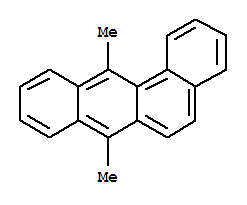Benz[a]anthracene,7,12-dimethyl- cas no:57-97-6
Synonyms: 7,12-Dimethylbenz[a]anthracene;9,10-Dimethyl-1,2-benz[a]anthracene;9,10-Dimethyl-1,2-benzanthracene;DMBA;DMBAn;NSC408823;
NameBenz[a]anthracene,7,12-dimethyl-
CAS57-97-6
Synonyms7,12-Dimethylbenz[a]anthracene;9,10-Dimethyl-1,2-benz[a]anthracene;9,10-Dimethyl-1,2-benzanthracene;DMBA;DMBAn;NSC408823;
EINECS(EC#)200-359-5
Molecular FormulaC20H16
Molecular Weight256.36
AppearanceYellow powder
refractive indexn20/D 1.501(lit.)
storage temp2-8°C
Globally Harmonized System of Classification adn Labelling of Chemicals(GHS)
Hazardclass6.1(b)
Hazard C: Corrosive;
Risk R22
Safety
Suspected carcinogen with experimental carcinogenic, neoplastigenic, tumorigenic, and teratogenic data. A transplacental carcinogen. Poison by ingestion, intravenous, subcutaneous, intraperitoneal, and intratracheal routes. Other experimental reproductive effects. Human mutation data reported. A skin irritant. When heated to decomposition it emits acrid smoke and irritating fumes.
Hazard Codes.gif) : C,
: C,.gif) T,
T,.gif) N,
N,.gif) Xn,
Xn,.gif) F
F
C: Corrosive
T: Toxic
N: Dangerous for the environment
Xn: Harmful
F: Highly Flammable
Risk Statements: 45-22-67-65-50/53-38-11-39/23/24/25-23/24/25
45: May cause cancer
22: Harmful if swallowed
65: Harmful: May cause lung damage if swallowed
67: Vapors may cause drowsiness and dizziness
11: Highly Flammable
23/24/25: Toxic by inhalation, in contact with skin and if swallowed
39/23/24/25: Toxic: danger of very serious irreversible effects through inhalation, in contact with skin and if swallowed
50/53: Very Toxic to aquatic organisms, may cause long-term adverse effects in the aquatic environment
38: Irritating to the skin
Safety Statements: 53-36/37-45-62-61-60
45: In case of accident or if you feel unwell, seek medical advice immediately (show the label where possible)
53: Avoid exposure - obtain special instructions before use
60: This material and/or its container must be disposed of as hazardous waste
61: Avoid release to the environment. Refer to special instructions safety data sheet
62: If swallowed, do not induce vomiting: seek medical advice immediately and show this container or label
36/37: Wear suitable protective clothing and gloves
F 10-13-23
F 10: Keep under argon
F 13: Malodorous
F 23: Sensitive to air
HazardClass: 6.1(b)
| 1. |
|
skn-mus 64 µg MLD
|
|
CALEDQ Cancer Letters (Shannon, Ireland). 4 (1978),333. |
| 2. |
|
dnd-hmn:emb 220 nmol/L
|
|
MUREAV Mutation Research. 89 (1981),95. |
| 3. |
|
dni-hmn:lvr 1 mmol/L
|
|
VOONAW Voprosy Onkologii. Problems of Onkology. 28 (11)(1982),53. |
| 4. |
|
otr-mus:emb 300 µg/L
|
|
PMRSDJ Progress in Mutation Research. 5 (1985),659. |
| 5. |
|
orl-rat TDLo:37,500 µg/kg (female 14-20D post):ETA,TER
|
|
CRNGDP Carcinogenesis. 3 (1978),413. |
| 6. |
|
ipr-rat TDLo:24 mg/kg (20D preg):ETA,TER
|
|
CCSUDL Carcinogenesis-A Comprehensive Survey 3 (1978),413. |
| 7. |
|
ivn-rat TDLo:15 mg/kg (21D preg):ETA,TER
|
|
JNCIAM Journal of the National Cancer Institute. 52 (1974),1365. |
| 8. |
|
ivn-rat TDLo:15 mg/kg (21D preg):ETA,TER
|
|
NEOLA4 Neoplasma. 23 (1976),285. |
| 9. |
|
imp-rat TDLo:11 µg/kg:ETA,TER
|
|
NISFAY Nippon Sanka Fujinka Gakkai Zasshi. Journal of Japanese Obstetrics and Gynecology. 34 (1982),1853. |
| 10. |
|
ipc-rat TDLo:1250 µg/kg:ETA,TER
|
|
GANNA2 Gann. Japanese Journal of Cancer Research. 62 ( |


.gif) : C,
: C,.gif) T,
T,.gif) N,
N,.gif) Xn,
Xn,.gif) F
F